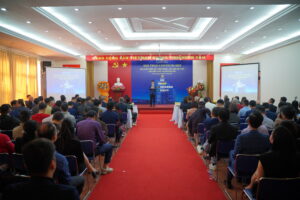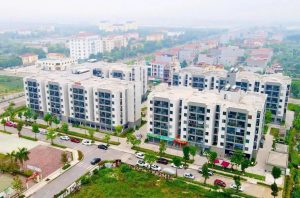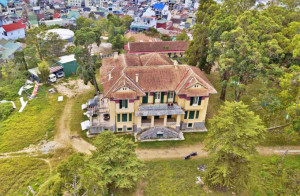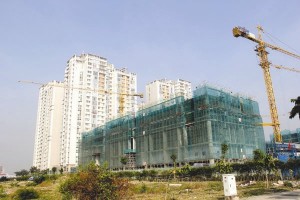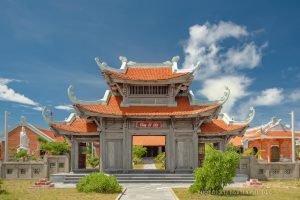Công bố quốc tế trong lĩnh vực kiến trúc, xây dựng (Tuần 3 tháng 11-2021)
Trong số này chúng tôi xin giới thiệu tới quý độc giả những nội dung chính của các công bố quốc tế đăng tải trên ScienceDirect và Springer Nature do Cục Thông tin khoa học và công nghệ quốc gia (NASATI) mua quyền truy cập như sau:
Quy hoạch đô thị:
- Các tác động năng lượng của hình thái đô thị từ quan điểm quy hoạch đô thị – Một nghiên cứu điển hình cho một khu vực phát triển đô thị mới ở thành phố Vienna
- Vai trò của các đặc điểm quy hoạch đô thị trong việc hình thành các thành phố chống chịu đại dịch – Nghiên cứu điển hình về tác động của Covid-19 đối với các thành phố châu Âu ở Anh, Đức và Ý
- Hướng tới các thành phố và cộng đồng mát mẻ: Một phương pháp phân tích độ nhạy để xác định các biến số thiết kế và quy hoạch chính cho các kỹ thuật giảm thiểu nhiệt đô thị
- Khung quản lý dữ liệu cho quy hoạch đô thị với chiến lược sử dụng cơ sở hạ tầng xanh-xanh
- Phân tích môi trường quan trọng của ba loại khu phố ở Trung Quốc và hiểu biết sâu sắc về quy hoạch đô thị bền vững
- Ứng dụng mô hình lũ lụt đô thị: Đánh giá hiệu quả của quy định xây dựng trong việc đối phó với lũ lụt đô thị trong điều kiện không chắc chắn về lượng mưa
- Khai thác đô thị trong các tòa nhà cho một nền kinh tế tuần hoàn: Quy hoạch, quy trình và triển vọng khả thi
- Lập kế hoạch trung tâm năng lượng di động cho các mạng đô thị phức tạp: Một cách tiếp cận tối ưu hóa mạnh mẽ
- Tìm kiếm sự khác biệt: Đo lường nhận thức không gian của các giai đoạn lập kế hoạch phát triển đô thị cao tầng trong Thực tế ảo
- Ứng dụng hệ thống thông tin địa lý (GIS) trong việc giảm các điểm đen tai nạn và quy hoạch mạng lưới đường đô thị an toàn hơn: Đánh giá
Khoa học và công nghệ trong lĩnh vực kiến trúc, xây dựng:
- Hệ thống xác định biến thể theo thời gian của cấu trúc thượng tầng của các tòa nhà biệt lập với cơ sở
- Mô hình khung thay thế chung (GSF) ước tính hiệu quả nhu cầu địa chấn của khung mô men thép và RC
- Phương trình điều khiển ứng suất trước khả thi và tính khả thi của các loại vòm cáp bề mặt quay mới
- Tính năng nén của cột bê tông nhiều ống vuông PEN FRP-bê tông-thép hình vuông kích thước lớn
- Kết hợp phân tích giới hạn trên-dưới cho cường độ cắt của dầm bê tông cốt thép ngang chịu lực căng dọc trục
- Độ bền mỏi của các mối nối thép cường độ cao và bình thường được cải thiện bằng cách tạo hình mối hàn
- Nghiên cứu thực nghiệm về tính năng tĩnh của khớp nối nhôm hợp kim nhôm dạng vòm
- Mô hình số hóa các vết cháy cục bộ trên các cấu trúc sử dụng FDS-FEM và các mô hình đơn giản
- Phương pháp thiết kế kết nối cột-móng ống thép thành mỏng bằng bê tông
Vật liệu xây dựng:
- Cơ chế biến tính của nhựa dầu mỏ C9 và ảnh hưởng của nó đối với nhựa đường biến tính SBS
- Cường độ chịu nén của gạch đất sét đặc của cầu xây: Ước tính thông qua các thử nghiệm Schmidt Hammer
- Nghiên cứu thực nghiệm độ bền của bê tông cốt sợi: Ảnh hưởng của sợi xenlulo, sợi polyvinyl alcohol và sợi polyolefin
- Biến dạng thể tích của bê tông đóng rắn bằng hơi nước bằng tro bay trong và sau khi đóng rắn bằng hơi nước
- Thực nghiệm nghiên cứu độ bền của bê tông cốt sợi: Ảnh hưởng của sợi xenlulo, sợi polyvinyl alcohol và sợi polyolefin
- Mô hình hóa mô phỏng thử nghiệm mặt đường bê tông nhựa đảo ngược: Nhấn mạnh vào các vết nứt trên nền đường bán cấp
- Nghiên cứu cải thiện khả năng chống thấm nước và khả năng hấp thụ nước của xi măng magie oxychloride sử dụng chất hoạt động bề mặt không ion organosilane chuỗi dài
- Sự thay đổi theo không gian của điện trở suất bê tông và tốc độ ăn mòn trong điều kiện phòng thí nghiệm
- Ảnh hưởng của Vải địa kỹ thuật không dệt (NWG) đến các đặc tính kỹ thuật của cát pha sét được xử lý bằng geopolyme gốc xỉ đồng
Xin trân trọng giới thiệu!
QUY HOẠCH ĐÔ THỊ
1.The energy implications of urban morphology from an urban planning perspective – A case study for a new urban development area in the city of Vienna Energy and Buildings
Volume 252, 1 December 2021, 111453, Energy and Buildings
Abstract
In view of advancing global warming, climate change adaptation and mitigation measures for buildings are becoming increasingly important. The following article discusses the question of whether current urban planning principles still provide a suitable framework for this purpose. Therefore, the aim of this paper is to identify and quantify the main parameters of the urban planning framework regarding energy demand and energy generation of buildings. In a novel, holistic approach, passive design measures were evaluated in a joint analysis based on a case study in the city of Vienna (Austria) with respect to their impact on heating and cooling energy demand, overheating potential, daylight availability, and solar potential of new buildings. The results show that by improving the thermal insulation of the building envelope, the importance of a high compactness of the buildings to lower the heating energy demand is decreased. In addition, moderate compactness can help reduce the energy demand for space cooling and artificial lighting and increase the solar potential of the buildings. Accordingly, the results question the dogma of a high degree of compactness that still exists to some extent and indicate that changing climatic conditions also require new approaches in the urban planning process.
2.Translations of sustainability in urban planning documents — A longitudinal study of comprehensive plans in three European cities
Cities, Volume 119, December 2021, 103360
Abstract
Sustainability is a concept characterized by its longevity: it remains, after several decades, a popular concept within public organizations, as well as public discourse more generally. In this paper, we trace various translations of sustainability in urban planning documents of three mid-sized cities in Northwest Europe. Emphasizing the importance of a longitudinal approach to assess the uses and definitions of sustainability, we examine translations of the concept across plans through an analytical framework that considers the hierarchical, sequential and integrative linkages between different urban policy documents to understand how local uses of the concept change or remain similar over time. The examination of change and continuity in the translations of sustainability offers insights into how the different manifestations of the concept are influenced by policies external to the city administrations, as well as by imitations of internal, previous policies. This study adds to previous research on contents of plans in relation to how descriptions of concepts take form in a web of interrelated planning and policy documents over time. This paper does so by showing how sustainability as a concept remains on the agenda by being translated into different times and settings, constantly reused with other ideas, and thereby made continuously relevant.
3.Role of urban planning characteristics in forming pandemic resilient cities – Case study of Covid-19 impacts on European cities within England, Germany and Italy
Cities, Volume 118, November 2021, 103324
Abstract
In recent decades, the world has witnessed a variety of emerging infectious diseases, some of which developed to pandemic world threatening outbreaks, the ongoing COVID-19 is known to be taking the lead in claiming lives around the globe and thus, urging people to trail its increasing figures. Therefore, this research aims to emphasize the role of urban planning in containing such outbreaks through running a series of analytical and statistical studies on European cities, worst inflicted region, to analyze the main urban features they share and that may be propagating the disease spread according to their population size, density, form, intracity connectivity and intercity connectivity. This study, as far as we know of, is the first practice to evaluate both the individual and combined impacts of these factors on recorded rates of infections. According to the context of this research, it is concluded that the diversity found in urban features are, to a large degree, related to cities being more vulnerable than others. Intracity connectivity through public transport is found to be the possible prime factor of this study, and is followed by population size, density, and intercity connectivity. Urban morphology seems to also contribute to such outbreak, with both radial and grid cities being associated to higher infections rates as to linear cities. Henceforth, setting priorities in post-pandemic urban planning schemes is essential for planning resilient cities that are capable to thrive and maintain functionality with lowest possible infections amid else possible diseases that are to follow in severity.
4.A data management framework for strategic urban planning using blue-green infrastructure
Journal of Environmental Management, Volume 299, 1 December 2021, 113658
Abstract
Spatial planning of Blue-Green Infrastructure (BGI) should ideally be based on well-evaluated and context specific solutions. One important obstacle to reach this goal relates to adequate provisioning of data to ensure good governance of BGI, i.e., appropriate planning, design, construction, and maintenance. This study explores the gap between data availability and implementation of BGI in urban planning authorities in Sweden. A multi method approach including brainstorming, semi-structured interviews with urban planners and experts on BGI and Geographical Information System (GIS), and validating workshops were performed to develop a framework for structured and user-friendly data collection and use. Identified challenges concern data availability, data management, and GIS knowledge. There is a need to improve the organisation of data management and the skills of trans-disciplinary cooperation to better understand and interpret different types of data. Moreover, different strategic goals require different data to ensure efficient planning of BGI. This calls for closer interactions between development of strategic political goals and data collection. The data management framework consists of three parts: A) Ideal structure of data management in relation to planning process, data infrastructure and organisational structure, and B) A generic list of data needed, and C) The development of structures for data gathering and access. We conclude that it is essential to develop pan-municipal data management systems that bridge sectors and disciplines to ensure efficient management of the urban environment, and which is able to support the involvement of citizens to collect and access relevant data. The framework can assist in such development.
5.Toward cool cities and communities: A sensitivity analysis method to identify the key planning and design variables for urban heat mitigation techniques
Sustainable Cities and Society, Volume 75, December 2021, 103377
Abstract
Cooling cities and communities requires impact assessment to explore the effectiveness of urban heat mitigation techniques (UHMTs) on multiple and possibly conflicting objectives, such as cooling potential, human health, and cost. This study developed a model integrating environmental, social and economic impact assessment and sensitivity analysis, which considers multiple objectives holistically and enables the key planning and design variables for UHMTs to be identified. The model consists of two components: (1) identifying the baseline and mitigation scenarios for UHMTs, and (2) integrating sensitivity analysis and environmental, social, and economic impact assessment, which can be tailored to a local urban context. An application in Leppington, Australia, is introduced to demonstrate the utility and implementation process of the model. Results show that the model can identify high-performance UHMTs and their key variables tailored to the Leppington case study and explore optimal solutions against multiple objectives. This study allows decision-makers to understand the environmental, social, and environmental impact of UHMTs holistically in their urban contexts, facilitating governments’ policy decision-making in urban heat mitigation and sustainable urban development.
6.What type of mixed-use and open? A critical environmental analysis of three neighborhood types in China and insights for sustainable urban planning
Landscape and Urban Planning, Volume 216, December 2021, 104221
Abstract
In the context of today’s global climate change and dramatic urban transformation, urban researchers, planners, architects, and policy-makers have recognized the value of following a mixed-use and open-oriented mode of urban development. In China, the prevailing option for urban renewal is the Urban Complex pattern, which features a mixed functional composition. However, due to its attributes of overall low urban walkability and high energy consumption, such super urban massing may not inspire an environmentally-friendly consequence or a healthy urban lifestyle among residents. This study adds an environmental dimension to the current debates on “sustainable urban form” and “inclusive and resilient neighborhood typology.” Based on an in-depth survey of the social and morphological characteristics of three representative mixed-use open urban neighborhoods (MOUN) in Shenzhen, this paper examines local-scale urban climate and canyon ventilation capacity performances of the following via on-site measurement: typical urban village (MOUN-Type I), mature open urban neighborhood (MOUN-Type II), and newly-built urban complex (MOUN-Type III). The results reveal that each MOUN type presents its merits and specific environmental problems, and their co-existence within cities can balance deficiencies in an inter-supplementary manner. The paper argues that urban (re)development should follow a multi-path and multi-consequence orientation, in which cities require the co-existence and collaboration of diverse neighborhood types to ensure a more efficient urban operation that strengthens urban adaptability. Even just from an environmental perspective, planners and policy-makers should carefully consider the specificity, continuity, and identity of each urban area situated within cities. Findings of this research provide insights into attaining “human-environment balance” in the process of establishing various planning models for urban sustainability.
7.Urban mining in buildings for a circular economy: Planning, process and feasibility prospects
Resources, Conservation and Recycling, Volume 174, November 2021, 105754
Abstract
The construction industry remains under immense pressure to reduce its material and climate related impacts. Increasing material demand and reduced building lifetimes have therefore motivated efforts for urban mining in buildings. Even though urban mining has been projected as a crucial measure for improving resource efficiency, its adoption as a practice in the construction industry remains at a very symbolic stage. Upscaling secondary resource recovery and reuse in the construction sector requires further efforts to understand urban mining feasibility from the perspective of project timelines, salvage time, skills and costs. Hence, this study develops an empirical research approach to measure urban mining feasibility and applies it to demolition-ready urban residential buildings stock in Singapore with semi-skilled construction workers. It develops indicators for urban mining feasibility based on planning stages, process change, behavioural practices and reuse-driven economic considerations. Based on urban mining of over 350 building components from 34 categories, results show an average of 1 to 12 min recovery time with an estimated urban mining cost from S$0.8 to S$9 per building component. Further, regulatory requirements for demolition permits can provide sufficient time for urban mining without affecting project timelines. Even though the mining skills of workers seem important, results highlights significant improvement in mining skills based on repeated salvage of specific building components. Results also provide robust evidence of reuse-driven urban mining feasibility in the case under study with significant prospects for embodied carbon savings. Overall, urban mining of buildings can contribute to net-zero targets and climate mitigation efforts with greater multi-stakeholder involvement and market push for reuse in the construction sector.
8.Urban Flood Modeling Application: Assess the Effectiveness of Building Regulation in Coping with Urban Flooding Under Precipitation Uncertainty
Sustainable Cities and Society, Volume 75, December 2021, 103294
Abstract
This research evaluates the effectiveness of planning and building regulations in coping with urban flooding under different precipitation scenarios. Accordingly, the study simulated seven alternative scenarios considering the variations of precipitation, plot coverage regulations, and Low Impact Development (LID) options. The study utilized open-source geospatial software to model different surface runoff scenarios. Then the effectiveness of those seven alternatives was assessed by utilizing the Analytical Hierarchy Process (AHP) technique to evaluate their sustainability in urban design. The results revealed that the plot coverage regulations are effective in managing floods during average rainfall events, and LID-based infrastructure solutions are effective during moderate rainfall events. Nevertheless, none of these solutions were solely adequate during extreme rainfall events. Regardless of the response to extreme rainfall occurrences, the practitioners’ opinion was in favour of green roof adoption and plot coverage regulation considering their effectiveness in managing more frequent average rainfall events, and the overall sustainability in maintaining the balance of urban hydrological pathways. Accordingly, the findings of the study can be utilized as a guide to the decision-making process in urban planning and design, and to formulate sustainable planning regulations and guidelines to cope with urban flooding under the precipitation uncertainty.
9.Mobile energy hub planning for complex urban networks: A robust optimization approach
Energy, Volume 235, 15 November 2021, 121424
Abstract
The electricity grid with a high penetration of renewable energy can enable travelers to travel free of emissions using state-of-the-art electric vehicles (EVs). Extensive electric vehicle demands at the peak-times, and an increase in electricity consumption due to population growth, have led to higher utility infrastructure investments. Mobile energy hubs i.e. clustered EVs parked in a dedicated location, can be used as an innovative demand-side management solution to reduce long-term utility infrastructure investments. They can store and release electricity to the grid based on consumer demand. However, a scientific planning approach for grid integration has been overlooked. Accordingly, this study proposes a comprehensive framework required to plan and develop mobile energy hubs based on optimization of life cycle cost, access distance and parking duration considering the temporal variation of EV recharging demands. The results of the study show that the framework developed can minimize lifecycle costs, and improve infrastructure utilization by accounting for the interests of all stakeholders. The total cost with the proposed robust optimization model under uncertainties of 50% is lesser than the robust cost calculated from a scenario-based approach. Furthermore, the developed framework is useful for recharging infrastructure planners to devise the deployment schedules and attract investors based on the economic viability of the planned strategies.
10.Finding the difference: Measuring spatial perception of planning phases of high-rise urban developments in Virtual Reality
Computers, Environment and Urban Systems, Volume 90, November 2021, 101685
Abstract
Planning is a process in which the contents of planning is gradually refined. However, research in planning communication and perception is often conducted using contrasting scenarios, e.g. by comparing a with/without case. It is not surprising that drastic differences in planning content and representation result in significant differences in perception. Instead, and as a reflection of sequential and gradually evolving projects in planning practice, we are focusing on two planning phases with only subtle differences (2015 and 2018) for a new high-rise development district in Guangzhou. We introduce 3D gaze-tracking and spatial perception experiments to investigate how participants respond to virtual representations of the two planning phases. The results provide implications for planning and design practice and suggest more substantial roles for the general public in participatory planning processes.
11.Application of geographical information system (GIS) in reducing accident blackspots and in planning of a safer urban road network: A review
Ecological Informatics, Volume 66, December 2021, 101436
Abstract
“Geographic Information System” (GIS) signifies a novel model for designing and organizing the information as well as information system respectively, whose essential aspect is basically utilizing concepts of location as a basis for information system’s structuring. As per the spatially distributed nature of the data which is associated to transport and the demand for several types of network-level analyses, statistical analysis, and spatial analysis and handling, the application of GIS is relevant for transportation. At the GIS platforms, the transportation network database is generally broadened through its linear referencing system by integrating several sets of its attributes and spatial data. In addition, GIS will facilitate integration with the transport network database of all other socio-economic data for the diverse planning functions. GIS also provides help to plan analyze a green environment. This paper reviews the need of analyzing the road accidents in urban areas through GIS based systems so, that we can reduce the number of accidents taking place and reducing the deaths occurring on roads due to these accidents which will be a great contribution towards the people of a country and its integrity. This paper aims to develop a base for developing a GIS based framework for analyzing the road accidents. It is also attempted through this paper to provide greater aspects for planning a greener and safer road environment.
12.Nonlinear relationship between urban form and street-level PM2.5 and CO based on mobile measurements and gradient boosting decision tree models
Building and Environment, Volume 205, November 2021, 108265
Abstract
Exposure to PM2.5 and CO has been proven to be closely related to physical health. Since 2012, they have been added to the pollutant list for national monitoring in Wuhan. However, the fine-scale variation in pollution, especially at the street level, is complex and requires further exploration. In this study, the influence of urban form on the street-level air pollution distribution was comprehensively assessed according to the urban factors, high-resolution meteorological data, PM2.5 and CO concentration data collected via mobile monitoring along roads in Wuhan. Furthermore, potential urban factors, including the land-use and urban form characteristics, were obtained from geographic information system. Both linear regression and gradient boosting decision tree (GBDT) models were developed to explore the relationship between the observed concentrations and the predictor variables. The modeling results demonstrate that the GBDT model, which captured the non-linear relationship, helps to better explain more of the variations in the pollutant concentrations than the linear model. This study provides insights into machine learning models for pollution prediction and demonstrate the important relationship between urban form and street-level pollutants. The results suggest that the urban form of the podium-level porosity can be set higher than 0.7 to promote the ventilation of street-level PM2.5 and CO, building density can be less than 0.35, and the standard deviation of height can be set to ~10 m in central Wuhan to mitigate street-level PM2.5. Thus, quantitatively demonstrating the impact of urban form on the PM2.5 and CO concentrations can help decision-makers with urban planning and management.
13.Understanding future urban growth, urban resilience and sustainable development of small cities using prediction-adaptation-resilience (PAR) approach
Sustainable Cities and Society, Volume 74, November 2021, 103196
Abstract
Rapid urban proliferation is an indispensable and reciprocal issue in contemporary urban planning and development. This study envisages the prediction-adaptation-resilience (PAR) approach to analyze the future urban landscape resilience and sustainable development goals (SDGs). We have selected a small, unplanned growing up city, namely, Krishnanagar urban agglomeration (KUA), in India, to apply the PAR approach. Therefore, land use land cover map has been prepared for 2000, 2010, and 2020. The result shows the built-up area has been increased most in past 20 years, from 6.36 km2 to 13.23 km2. Then, the cellular automata-Markov chain model is applied to predict the future potential urban development surface for 2030 and 2040. The receiver operating characteristic (ROC) curve shows 83.6% success rate between the predicted and actual map of CA-Markov. The prediction map of 2030 and 2040 shows that the built-up area continuously expands (13.23 km2 to 16.52 km2) towards KUA’s surrounding regions. Consequently, other decreasing land classes will be a threat to SDGs and urban resilience. So, people of KUA are adopting the changing hostile nature of urbanisation and urban vulnerability. Hence, this study will help the local administration to make a proper urban planning and adaptation strategies by maintaining good urban governance to achieve 8 SDGs of UN’s 2030 Agenda in future.
14.Influence of urban forms on long-duration urban flooding: Laboratory experiments and computational analysis
Journal of Hydrology, Volume 603, Part C, December 2021, 127034
Abstract
Water-sensitive urban design is an integral part of flood risk management. Based on computational modelling, we investigated the influence of various urban forms on flooding severity at the level of an urban block and for the case of long-duration urban flooding. The upstream flow depths, downstream discharge partition and flow exchange through the urban forms were examined. The results indicate that one urban characteristic has an overwhelming influence on the flow variables: the conveyance porosity in the main flow direction is by far more influential than the conveyance porosity in the normal direction or the number of streets. Such anisotropic effect was not pointed in recent similar studies, and it hints at practical guidelines for sustainable urban planning in practice. Moreover, the computational model was verified against laboratory observations, which constitute a novel valuable dataset for the validation of other urban flooding models.
15.New urban models for more sustainable, liveable and healthier cities post covid19; reducing air pollution, noise and heat island effects and increasing green space and physical activity
Environment International, Volume 157, December 2021, 106850
Abstract
Cities are centres of innovation and wealth creation, but also hotspots of air pollution and noise, heat island effects and lack of green space, which are all detrimental to human health. They are also hotspots of COVID19. COVID19 has led to a rethink of urban public space. Therefore, is it time to re-think our urban models and reduce the health burden?
We provide a narrative meta-review around a number of cutting edge and visionary urban models that that may affect health and that have been reported over the past few years.
New urban concepts such as the Superblocks, the low traffic neighbourhood, 15 Minute city, Car free city or a mixture of these that may go some way in reducing the health burden related to current urban and transport practices. They will reduce air pollution and noise, heat island effects and increase green space and physical activity levels. What is still lacking though is a thorough evaluation of the effectiveness and acceptability of the schemes and the impacts on not only health, but also liveability and sustainability, although they are expected to be positive.
Finally, the COVID19 pandemic may accelerate these developments and stimulus funding like the EU Next Generation funding should be used to make these changes.
16.Compatibility of quantitative and qualitative data-collection protocols for urban soundscape evaluation
Sustainable Cities and Society, Volume 74, November 2021, 103259
Abstract
This study investigates the compatibility of soundscape evaluation results based on the data-collection protocols proposed in ISO 12913-2, Method A (questionnaire), Method B (questionnaire and open-answer), and Method C (narrative interview), as well as guidelines for evaluating urban soundscapes. We assessed the soundscapes of 10 multi-functional sites in an urban environment through the responses of 50 participants to questions on sound source identification, perceived affective quality, and overall quality. Using virtual reality technology, we reproduced a laboratory environment similar to the actual assessment sites. The responses to sound source identification were similar for each protocol. Regarding perceived affective quality, the “pleasantness-eventfulness model” derived from Method A was also found in the text-mining results of Methods B and C; additional emotional responses were discovered. Regarding overall quality, the preference for each assessment site was similar for each protocol. Method C revealed the influence of non-acoustic factors on soundscape perception. The quantitative data protocol was appropriate for a large group and for deriving a generalized model, whereas the qualitative data protocol was effective for small groups or an in-depth analysis of certain sites. The findings of this study are useful for assessing urban soundscapes and informing urban planning.
17.Assessing the inequities in access to peri-urban parks at the regional level: A case study in China’s largest urban agglomeration
Urban Forestry & Urban Greening, Volume 65, November 2021, 127334
Abstract
Access to peri-urban parks (PUPs) has recently gained considerable attention because of the limited green space in urban areas that cannot meet residents’ increasing demands for engaging with nature. Here, we aim to assess the accessibility to PUPs and monitor the underserved areas in the context of urban agglomeration, and to examine the inequities across districts with heterogeneous social groups. A Huff-2SFCA (Huff-two step floating catchment area) model was developed to evaluate the PUP accessibility. In addition, we adopted 30, 60, 90, 120, and 150 min as the threshold of travel time to identify the areas that are underserved by PUPs. Welch’s ANOVA test (one-way ANOVA with unequal variances) was used to monitor the disparities in PUP accessibility among different cities, and a bivariate correlation was used to explore the associations between PUP accessibility and socioeconomic variables. Factor analysis (using varimax rotation) was then applied to cluster socioeconomic indicators into three factors, which were further divided into four quartiles. Lastly, the average value of PUP accessibility in each quartile group was calculated and compared to measure inequities. The Yangtze River Delta urban agglomeration (YRDUA), China’s largest urban agglomeration, was selected as the case study. The results suggested the following: 1) PUP accessibility increases while the number of underserved subdistricts decreases as the threshold value of travel time increases from 30 to 150 min, and 90 min is a ‘turning point’, after which an increasingly small difference is suggested both in PUP accessibility and underserved subdistricts; 2) there are statistically significant disparities in PUP accessibility across different cities in YRDUA; and 3) the socioeconomically disadvantaged districts have fewer opportunities to enjoy PUP services, while districts with lower social status groups or higher ethnic minority populations were not treated unequally. Our findings contribute to the environmental justice paradigm by assessing the inequities in access to PUPs over an extensive geographical scope, which could help decision-makers formulate effective policies and strategies for improving nature exposure from a regional planning perspective.
KHOA HỌC VÀ CÔNG NGHỆ TRONG LĨNH VỰC KIẾN TRÚC, XÂY DỰNG
1. Time variant system identification of superstructures of base-isolated buildings
Engineering Structures, Volume 246, 1 November 2021, 112697
Abstract
The time-variant dynamic properties related to the superstructure of base-isolated (BI) buildings are identified using a simple substructure approach. Based on the acceleration data recorded in BI buildings during earthquake events, the short-time deterministic-stochastic subspace identification (STDSI) method and a novel short-time transfer function (STTF) method are used to identify the temporal evolution of the modal properties of the superstructure, which can be consequently employed to study the evolution of its potential damage. The proposed substructure approach is applied to experimental data from three BI structures: a building numerically simulated using the commercial software SAP2000, a full-scale five-story reinforced concrete BI building tested at different intensity levels on a large-scale shake table, and an instrumented four-story reinforced masonry building located in Chile. The results indicate that the identified modal properties obtained for the superstructure by using the proposed approach are comparable to those obtained from the corresponding fixed-base (FB) buildings, allowing to study in detail the dynamic behavior of BI buildings’ superstructures disaggregating the highly inelastic response associated with the seismic isolation system.
2.General Substitute Frame Model (GSF) for efficient estimation of seismic demands of steel and RC moment frames
Engineering Structures, Volume 246, 1 November 2021, 113031
Abstract
This paper proposes an approach to simplify 2D moment-resisting frames (with equal or non-equal bay lengths) to an equivalent single-bay framed MDOF model. This model, named the General Substitute Frame (GSF), is a promising development of the recently introduced Substitute Frame (SF) model by the authors that was restricted to equal-bay moment frames. The proposed GSF model which resolves the limitation of the SF model is applicable for both the steel and RC moment frames from low-rise to high-rise buildings. In order to evaluate the accuracy of the GSF model rigorously, a combination of 24 full-frame 2D moment frames including 4-, 12-, and 20-story buildings was designed and the results of nonlinear dynamic analyses were compared with their corresponding GSF models in terms of engineering demand parameters. In addition, modal and pushover analyses were also performed. Earthquake ground motions employed in this study include mild far-fault, moderate far-fault, and severe near-fault records selected by the Conditional Spectrum method. To accurately perform the required analyses, OpenSEES software was used, and 3600 runs of nonlinear time history analysis have been carried out. Based on the results of the analyses, it was demonstrated that the GSF model could predict the seismic response of moment frames well enough into both the linear and nonlinear ranges with high accuracy and can be a reliably practical substitution for moment-resisting frames. Moreover, the GSF model can be easily extracted from the primary full-frame based on the proposed equations.
3.Control equation of feasible pre-stresses and feasibility of new types of rotating surface cable domes
Engineering Structures, Volume 246, 1 November 2021, 113000
Abstract
The study proposes the control equation of feasible pre-stresses and the corresponding solving algorithm, and verifies three new types of rotating surface cable domes. First, the study takes that the structural displacements are zero as the control equation of feasible pre-stresses, and proposes a novel solving algorithm based on that target values of structural displacements are zero. Second, the study develops three new types of cable domes with different rotating surfaces, which have different Gaussian curvature. And then their feasibility in nature are verified through determining their feasible pre-stresses using the solving algorithm. Last, their ultimate bearing capacity under full and half-span vertical loads are investigated. The results indicate that the solving algorithm can determine the feasible pre-stresses efficiently and accurately, and three new cable domes proposed in the study are feasible in nature, and they have sufficient stiffness to bear external loads. The appearance of the three new rotating surface cable domes extends the cable domes from the traditional positive Gaussian curvature to the zero Gaussian and negative Gaussian curvature.
4.Blast behavior of steel-concrete-steel sandwich panel: Experiment and numerical simulation
Engineering Structures, Volume 246, 1 November 2021, 112998
Abstract
As a lateral resisting element, the steel–concrete composite structure has been gradually employed in the anti-seismic and the anti-explosion design of structures due to the favorable capacity of energy dissipation and impact resistance. The blast capacities of steel–concrete-steel (SCS) sandwich, concrete-steel–concrete (CSC), and reinforced concrete (RC) slabs were investigated by experiment and numerical simulation. The effects of the explosive charge, concrete grade, steel plate thickness, and length of shear studs on the blast behaviors of the composite slabs were studied by parametric analysis. The failure modes and dynamic responses of the specimens were investigated and compared. Simultaneously, the empirical formulas for mid-span deflection of the SCS and CSC slabs were proposed by using a multiple nonlinear regression analysis method. The results indicated that the three specimens exhibit different failure modes, in terms of local damage, spallation of concrete, and punching failure. And the steel plate takes a dominant role against the blast loads, which can provide a robust protective capacity to prevent the slab from damage due to the high tensile strength of steel. The SCS sandwich slab has the smallest damaged area on the front steel plate with a smaller mid-span displacement, maintains the integrity, and owns bearing capacity after the blast test compared with the CSC and RC members. The proposed empirical formula can well fit the relation among the deflection of the composite slabs, explosive charge, and thickness of steel plate, which can reasonably predict the midspan displacements of the composite slabs.
5.Compressive behavior of large-size square PEN FRP-concrete-steel hybrid multi-tube concrete columns
Engineering Structures, Volume 246, 1 November 2021, 113017
Abstract
Fiber-reinforced polymer (FRP)-concrete-steel hybrid multi-tube concrete column (MTCC) is a new type of composite column and comprises a number of steel inner tubes, an FRP external tube and concrete fillings for the space inside all the tubes. This paper presents a series of experimental tests on four large-size square PEN (polyethylene naphthalate) FRP-MTCCs, of which the PEN fibers were extracted from recycled plastic bottles. The parameters of interest include the FRP thickness and the steel tube configuration. The experimental results showed that the large-size square MTCCs with PEN FRP exhibited excellent ductility due to the effective confinement provided by PEN FRP jacket and steel tubes. A prediction method for the square PEN FRP-MTCCs has been developed in the present study to consider the unique characteristics of the column and is able to produce reasonable predictions for the experimental results. This study serves to present an innovative alternative in an environmentally friendly way that can replace the conventional bridge piers in coastal and salina regions.
6.Combined upper–lower bound analysis for shear strength of transversely reinforced concrete beams under axial tension
Engineering Structures, Volume 246, 1 November 2021, 112970
Abstract
Axial tension force exerted because of a temperature change or shrinkage can cause the collapse of reinforced concrete (RC) structural members. Earlier work on this subject has revealed that axial tension imposed on a lightly reinforced section led to the partial collapse of the Wilkins Air Force Depot in 1955. Design code provisions and analytical models such as modified compression field theory yield reasonable estimates of shear strength of RC beams subjected to axial tension. Nevertheless, their semi-empirical nature is not always appropriate for shear assessment of existing RC structural members. The extra conservativeness and empirically determined parameters can incorrectly estimate the actual strengths of existing structures. A generalized mechanical model with rigorous formulation must be developed. This paper presents an analytical model that is useful to predict the shear strength of RC beams with transverse reinforcement under axial tension. Without regressive functions or empirical parameters, the combined upper and lower bound analysis enables shear strength derivation based on the force equilibrium and compatible patterns of failure. The accuracy of these analyses has been validated through comparison of its predictions with five available experimental campaigns and international shear design expressions as well as the modified compression field theory. Comparisons reveal the limitations of design code provisions and the general validity of the developed analysis.
7.Fatigue strength of normal and high strength steel joints improved by weld profiling
Engineering Structures, Volume 246, 1 November 2021, 113030
Abstract
While some post-weld treatment techniques increase the fatigue life mainly due to induced compressive residual stress others are trying to create a smooth transition at weld toes. One of the latter is weld profiling. This study investigates the effect of weld profiling for four different steel types from S355 to S900 including one duplex stainless-steel and performs a comparison with high frequency mechanical impact (HFMI) treatment. The observed fatigue strength improvement is significantly higher than typically assumed for such techniques and comparable to increases observed for HFMI treatment. The fatigue strength further increases with parent material strength and is only slightly below the estimated fatigue strength of the parent material. Finally, fatigue design curves are proposed for weld profiling that include an increasing fatigue strength improvement for higher strength materials, but that are still conservative for low weld quality.
8.Experimental study on the static performance of arched aluminium alloy gusset joints
Engineering Structures, Volume 246, 1 November 2021, 113013
Abstract
A gusset joint with 7° arch angle comprised of two upper and lower aluminium alloy joint plates and four H-shaped aluminium alloy members connected by Huck bolts is first designed and the static performance experiment is carried out to address the research gap regarding the static performance of arched aluminium alloy gusset joints. The failure modes of the joint are summarized in terms of the collapse phenomena, namely the local buckling of the web and the bending and torsion failure of the member, and the stress distribution is discussed based on the measured strain. Subsequently, the ultimate bearing capacity and the stiffness in different stages of the load–displacement curve are obtained. The analysis is then developed via finite element (FE) models implemented in the non-linear code ABAQUS. First, via comparison with the experimental results, the validity of the FE model is verified. Furthermore, according to the simulation, it reveals that with the plasticity development of bolt hole walls, the joint gradually reaches the ultimate bearing capacity and undergoes the obvious deformation utill it can not bear the load. To develop further understanding, the effects of different arch angles on the bearing capacity, stiffness, and failure modes of joints are investigated, and the results indicates that arch angles cannot be ignored.
9.Numerical modeling of localized fire exposures on structures using FDS-FEM and simple models
Engineering Structures, Volume 246, 1 November 2021, 112997
Abstract
This paper investigates different numerical modeling strategies for evaluating temperatures in structures subjected to localized fires. Three simple fire models and two methods to interface computational fluid dynamics models with finite element thermal analyses are reviewed. Based on the field of application of each model, a decision flowchart is proposed to select the fire model and strategy suited to the problem. Validation is conducted against three experiments on steel members subjected to localized fires. Results show that the coupling between computational fluid dynamics and finite element analysis through the adiabatic surface temperature is a versatile method able to capture the member temperature in the different experiments in this study. The use of an automatic transfer interface using a transfer file with gas temperatures and radiant intensities is an efficient alternative when the member is outside the fire area and far enough that it does not significantly influence the fire development. The member should not be present in the FDS model when using the interface method. The simple models tend to yield more conservative predictions compared with the experimental results.
10.Reinforced concrete structural elements cast into wood-chip cement formworks subjected to compression and out-of-plane bending
Engineering Structures, Volume 246, 1 November 2021, 112990
Abstract
The mechanical response of reinforced concrete walls cast into permanent woodchip-cement formworks and subjected to eccentric compression has been assessed with experimental tests of full-scale panels and an analytical approach has been proposed. The load-bearing capacity of the wall panel is assured by the inner reinforced concrete grid structure, composed of vertical columns and horizontal ribs, reinforced with vertical and horizontal steel bars. The experimental specimens were realized varying the concrete cross-section and tested varying the eccentricity of the applied vertical load. Both reinforced and non-reinforced panels were tested. An analytical model is proposed to evaluate the load-bearing capacity, based on dimensionless curves, which provide reduction coefficients of strength based on eccentricity and slenderness, considering second-order effects. The analytical model demonstrates a reliable prediction of the experimental peak loads.
11.Damage assessment of prefabricated prestressed channel slab under plane charge blast
Engineering Structures, Volume 246, 1 November 2021, 113021
Abstract
The study of the mechanical properties of prestressed concrete channel slabs under different plane charge air blasts for applications in civil defense engineering is significant. For this reason, similar simulation tests were conducted on the anti-explosive performance of three 1:3 scale prestressed concrete channel slabs under 9 times plane charge air blast. The positive duration was more than 260 ms to simulate the uniform distribution load of a strong blast air shock wave on the prestressed concrete channel slab. The results showed that the designed prestressed concrete channel slab had good displacement ductility without brittle destruction, which significantly reduced the damage of the blasting impact on the structure. The channel slab could resist an air shock load of 0.467 MPa without damage. On the other hand, the positive duration was not only related to the quality of the overlying soil but also related to the air shock wave overpressure design value. The channel plate is regarded as a rigid-plastic component to calculate its plastic dynamic response under explosive load. In addition, the reliability of the theoretical calculation results and ABAQUS software simulation were verified by experimental data, which provided a feasible analytical method for calculation and simulation research in civil air defense engineering.
12.Determination of the interfacial properties of longitudinal continuous slab track via a field test and ANN-based approaches
Engineering Structures, Volume 246, 1 November 2021, 113039
Abstract
Due to the common existence of interlayer debonding and separation of longitudinal continuous slab track (LCST), accurately estimating the interfacial normal cohesive parameters between the concrete track slab and the cement emulsified asphalt (CA) mortar layer is an important task. This study first carried out a full-scale vertical pull test (VPT) to study the interfacial normal bond capacity of LCST. As a result, a series of load–displacement curves were measured. Then, an artificial neural network (ANN)-based approach was developed to map the relationship between the structural response and the interfacial properties under a machine learning (ML) framework. In addition, a refined macroscale finite element (FE) model that employed the exponential cohesive zone model (CZM) was established to simulate the interfacial debonding process. Two datasets of the global load–displacement and the local stress-slip responses obtained from the FE analysis were separately used to train and verify the ANN. Our results showed that the predictions given by the ANNs and the ground truth values were in close agreement. Furthermore, by feeding the well-trained ANN with the experimental load–displacement curves of the VPT, the realistic interfacial normal cohesive parameters of LCST were identified. Afterward, a comparative analysis of the experimental results and the recovered results according to the identified parameters was carried out. The results showed that the proposed parameter determination method is accurate and reliable. The developed hybrid approach that combines experimental and FE analysis with ML methods can be a promising alternative for identifying material properties in structural engineering.
13.Wheel-rail impact at an insulated rail joint in an embedded rail system
Engineering Structures, Volume 246, 1 November 2021, 113026
Abstract
With dynamic behaviour different from that of traditional discretely supported tracks, continuously supported embedded rail systems (ERSs) have been increasingly used in railway bridges, level crossings, trams, and high-speed lines. However, studies on ERSs have been limited, and none of them have addressed the wheel-rail impact-induced dynamic response, although wheel-rail impact is a main cause of ERS degradation. This paper studies, numerically and experimentally, the wheel-rail impact at an insulated rail joint (IRJ) used in the ERS. As a weak spot of the track, the IRJ results in discontinuities in the track support stiffness and wheel-rail contact geometry. This study first develops an explicit finite element model to simulate the vibration responses of the IRJ in the ERS when excited by a hammer and passing wheel loads. The simulated dynamic behaviours (represented by the hammer-excitation frequency response function) at a frequency up to 5 kHz and a wheel-rail impact vibration frequency up to 10 kHz are then validated with a field hammer test and a train pass-by measurement, respectively. Both the experimental study and numerical modelling reveals that the major frequencies of the impact vibration at the IRJ in the ERS depend mainly on geometric irregularities in the IRJ region and the train speed, rather than on the resonances of the track structure, as in the case of the discretely supported IRJ. This finding is meaningful to the engineering practice because it indicates a continuously supported IRJ in the ERS is more impact resistant, especially when the IRJ geometry is adequately maintained, e.g. by timely grinding.
14.Design method of concrete filled thin-walled steel tube column-foundation connections
Engineering Structures, Volume 246, 1 November 2021, 113033
Abstract
The anchor rebar column-foundation connection (SAC) has been proposed for the concrete filled steel tube (CFST) column. To enhance the load transfer between the steel tube and concrete, shear hoop rings or perfobond strips (PBLs) could be used, forming the SAC-H and SAC-P, respectively. Anchor rebars could be directly welded onto the surface of steel tube (SAC-W) to transfer the axial load. To date, experimental studies have been conducted to investigate the seismic performance of the four novel types of column-foundation connections. To facilitate the application of the proposed connections, design methods are explored and proposed in this paper. A test database is assembled first, followed by the development of the finite element model (FEM). On the basis of a parametric study, design methods for the sectional strength and elastic stiffness are proposed.
15.Characterization of bridge substructures explored by leveraging structural identification of a scaled bridge model
Engineering Structures, Volume 246, 1 November 2021, 112953
Abstract
Characterization and evaluation of bridge substructures, especially when as-built information is missing, are needed to assess the vulnerability of bridges to natural hazards, other possible causes of bridge failure, and as prerequisites for bridge substructure and foundation reuse. Structural identification has been investigated as a tool for characterizing and evaluating bridge substructures. Structural identification offers advantages over conventional methods especially by integrating information from structural testing and local NDE approaches.
During field investigations the authors observed significant challenges to assessing substructure characteristics such as embedded depth, even for simple piers on spread footing foundations. It is found that impact excitation on bridge superstructure or even directly on substructure aiming for conventional flexural modes in the lower frequency band is not sufficient for a reliable identification of the substructure and its surrounding soil.
To understand better the challenges limiting reliable structural identification of bridge substructures, a phenomenological scaled bridge model with strip footing, mimicking an actual bridge on shallow foundations, was designed, fabricated and utilized for controlled laboratory testing. The scaled bridge model could be modified to comprehend the sensitivity of bridge substructure modal properties to: i) stiffness of bridge bearings (causing coupling between superstructure and substructure) and ii) foundation substrate compliance. A finite element representation of the physical model, with a Multiphysics Simulation Finite Element Software, was calibrated and was then exploited to perform further sensitivity studies which confirmed the potential of high frequency axial and flexural modes of the substructures to: iii) identify shallow foundation embedded depth, and iv) characterize the soil substructure interaction.
Throughout the paper, different challenges affecting structural identification for characterization and evaluation of bridge substructures and possible countermeasures are discussed. Findings of the study indicate that a high frequency bandwidth covering the axial vibrational modes of the substructure is necessary if structural identification is used for estimating shallow foundation embedded depth. Such a bandwidth is not possible in conjunction with ambient monitoring, pointing to the necessity of a controlled multi-inputmultioutput (MIMO) dynamic testing.
16.Performance of a moment resisting beam-column connection for precast concrete construction
Engineering Structures, Volume 246, 1 November 2021, 113005
Abstract
Seismic performance of a specific type of moment resisting precast concrete beam-column connection was investigated through reversed cyclic load tests. Structural steel components were incorporated with precast concrete beam and column elements in the experiments to provide a ductile moment resisting connection. Additionally, nonlinear finite element analysis (FEA) of typical monolithic and precast connections was performed to investigate the performance and failure modes of these connections. Concrete Damage Plasticity (CDP) model was used to capture nonlinearities in concrete under cyclic loading. Good agreement was achieved between experimental and numerical results, which indicates that the finite element model is capable of capturing failure modes of the investigated precast connections. Agreement between the experimental and numerical behaviors was valid in terms of both the global load–displacement response as well as the local response, such as the force within connection rods and the beam curvature. Behavior of the precast concrete connection was influenced significantly by the anchorage detail used for steel connection plates and the beam reinforcement detailing in the vicinity of the connection. Simple detailing modifications resulted in major improvements in the performance of connection in terms of strength, stiffness and energy dissipation characteristics.
VẬT LIỆU XÂY DỰNG
1.Calibration of mechanics-based pavement predictive framework for top-down cracking performance of flexible pavement considering wheel wander effect
Construction and Building Materials, Volume 306, 1 November 2021, 124792
Abstract
This study presents a pavement analysis framework for top-down cracking (TDC) for flexible pavements with considerations of the effects of lateral wheel wander on the long-term pavement performance. A mechanics-based pavement analysis framework developed for predicting TDC is adopted and extended to account for the influence of lateral wheel wander on long-term pavement performance. The mechanics-based pavement analysis model was developed based on the HMA Fracture Mechanics with thresholds introduced to capture the changes in the asphalt concrete mixture resistances to damage and fracture. The fracture resistance and healing propensity of mixture are correlated to mixture morphology to account for the contribution of mixture morphology to these key mixture properties. A failure-curve calibration methodology is developed and implemented using pavement sections with well-documented performance histories from Florida. By accounting for a more realistic representation of the traffic conditions, the calibrated framework delivered accurate predictions of the long-term top-down cracking performance of the pavement sections considered in the study. The TDC performance of pavement for non-wheel wander scenario is evaluated to simulate the loading characteristic of autonomous trucks. A comparative evaluation of the pavement performance for traffic conditions with lateral wheel wander, and the non-wheel wander case was performed. As expected, the results indicate a higher level of accumulated damage in the non-wheel wonder case. The crack initiation time (i.e., the number of years to initiation of cracks) of all pavement sections for non-wheel wander cases is earlier than those with lateral wheel wander. The results show that the non-wheel wander case (autonomous truck scenario) can account for about a 20% reduction in pavement life depending on the traffic volume, pavement structure, materials, and climatic conditions. In addition, the results further exhibit that pavement sections with different traffic volumes exhibited a varying degree of sensitivity to the effect of wheel wander on the long-term performance.
2.Modification mechanism of C9 petroleum resin and its influence on SBS modified asphalt
Construction and Building Materials, Volume 306, 1 November 2021, 124740
Abstract
In this paper, C9 petroleum resin was used as the raw material, and the microstructure of C9/SBS modified asphalt at a different time under different C9 petroleum resin content was studied by fluorescence microscope. The mechanical properties were studied by using the whole section fracture energy, the pavement performance of C9/SBS modified asphalt was tested and analyzed. The results show that C9 petroleum resin is conducive to SBS particles being sheared into smaller particles under the same preparation process. The larger the content of C9 petroleum resin, the smaller the final size of SBS particles, and the smallest SBS particle size can be reduced by about half. When the content of C9 petroleum resin is more than 9%, the decreasing trend is no longer obvious. This phenomenon mainly occurs in the final stage of shearing. C9 petroleum resin can affect the swelling behaviour of SBS in asphalt and its final microstructure by reducing the particle size of SBS. The larger the content of C9 petroleum resin, the larger the area occupied by SBS after swelling, and the longer the skeleton length of SBS, the easier the crosslinking occurs and the denser the crosslinking network structure is formed. The addition of C9 petroleum resin can effectively improve the fracture energy density of SBS modified asphalt, and its mechanism is closely related to the effect of C9 petroleum resin on the shear particle size and final swelling degree of SBS particles. C9 petroleum resin can effectively hinder the floating and aggregation of SBS modifier in asphalt during high-temperature storage, thus improving the storage stability of SBS modified asphalt. The incorporation of C9 petroleum resin can significantly increase the viscosity of SBS modified asphalt, improve the low-temperature performance of SBS modified asphalt, and improve the anti-ageing performance of SBS modified asphalt. The results provide a new way to improve the performances of SBS modified asphalt.
3.Compressive strength of solid clay brickwork of masonry bridges: Estimate through Schmidt Hammer tests
Construction and Building Materials, Volume 306, 1 November 2021, 124494
Abstract
Theoretical approaches and code formulas assume the compressive strength of solid clay brickwork as a function of the compressive strength of bricks and mortar. Such an approach is not so easy to be applied in practice since the strength of the components may be identified only by means of indirect testing through rebound hammers or penetrometers.
Since brickwork strength largely depends on the brick properties, the mortar playing a minor role, a low detailed and fast estimate of brickwork strength may be deduced from the bricks only. In this paper, the type-N Schmidt rebound hammer, i.e. the standard one for concrete, is applied to the solid clay brickwork of arch bridges and industrial facilities. Due to the higher quality of the materials used in these cases, on the basis of a specific calibration curve, the rebound hammer is demonstrated to provide an estimate of the compressive strength affected by a ±25% error. Relying on a large data base, it is showed that in other cases, mainly residential buildings, such an approach is not applicable due to the lower quality of materials and larger scattering of the mechanical properties.
4.Experimental study on durability of fiber reinforced concrete: Effect of cellulose fiber, polyvinyl alcohol fiber and polyolefin fiber
Construction and Building Materials, Volume 306, 1 November 2021, 124867
Abstract
The durability of concrete reinforced by cellulose fiber (CTF), polyvinyl alcohol fiber (PF) and polyolefin fiber (VS) is comprehensively studied in this paper. Relevant durability tests are conducted to explore the effect of different fiber types and dosages on durability performance demonstrated in the resistance to drying shrinkage, water permeability, crack, carbonization and chloride ion penetration. Besides single fiber reinforced concrete, synergistic effect of hybrid fibers on durability is also studied, and the service life of fiber reinforced concrete in carbonization environment and chloride ion corrosive environment is further predicted. In addition, the structure of fiber reinforced concrete is analyzed from the micro perspective by using the optical and electron microscope. The results showed that: (1) The addition of CTF can effectively enhance the all five aspects of durability performance, including the resistance to drying shrinkage, water permeability, crack, carbonization and chloride ion penetration. The addition of PF can enhance the durability properties except for chloride ion penetration resistance. Generally, though with few exceptions, the increased dosage of CTF or PF would improve the strengthening effect on the durability of single fiber reinforced concrete. The addition of VS can either enhance or weaken the above five aspects of durability properties, and its effect varies much with the fiber dosage. (2) Hybrid fiber is found to have a positive synergistic effect and enhance the above five aspects of durability properties of concrete. The concrete reinforced with the hybrid fiber combination of 1.2 kg/m3 CTF, 2.0 kg/m3 PF and 2.0 kg/m3 VS may achieve the optimal durability properties. (3) CTF, PF and VS, especially their hybrid combinations, are found to effectively prolong the service life of concrete structure in the carbonization and chloride ion corrosive environment. The research findings obtained in this paper can supplement the study on the durability of fiber reinforced concrete, and provide suggestions for suitable fiber type and dosage selection in actual engineering designs of fiber reinforced concrete.
5.Volume deformation of steam-cured concrete with fly ash during and after steam curing
Construction and Building Materials, Volume 306, 1 November 2021, 124854
Abstract
Steam-cured concrete presents high compressive strength at an early age. However, understanding regarding temperature-induced deformation development in steam–cured concrete with fly ash is limited. In the present research, the volume deformation of fly ash concrete experienced steam curing stage at an early age has been carried out. Volume deformation of concrete without fly ash is also studied as a comparison. In order to obtain the in situ property changes of steam-cured concrete, a strain-temperature-humidity integrated acquisition system was used to continuously record the interior strain, temperature, and humidity evolutions of the sample. The test results show that the autogenous shrinkage occurs at the constant temperature stage of steam curing, and the shrinkage after steam curing is mainly because of the drying effect. The addition of fly ash can increase the development of shrinkage in steam curing, but it is beneficial to shrinkage after steam curing. And the hydration degree prediction development model of steam-cured cement paste is proposed. Finally, a micromechanical model is proposed based on the capillary tension produced by pores, using interior humidity and hydration degree as the driving parameters, which decently predicts the total shrinkage and autogenous shrinkage of concrete specimens after steam curing.
6.Modeling to simulate inverted asphalt pavement testing: An emphasis on cracks in the semirigid subbase
Construction and Building Materials, Volume 306, 1 November 2021, 124790
Abstract
Typical inverted asphalt pavement (IAP) finite element (FE) models consider the semirigid subbase as an intact slab. Quarter IAP FE models with cracks in the subbase are developed to include the effect of cracks on pavement responses. To facilitate the model validation, heavy vehicle simulator (HVS) accelerated pavement testing (APT) and falling weight deflectometer (FWD) tests are conducted on four instrumented IAP test sections with transverse cracks sawed into the top of the subbase. The crack is simulated with cohesive elements, and the loading part geometry and dimension are determined by measuring the tire-pavement contact characteristics of the HVS dual-wheel carriage. The minimum mesh size of 0.01 m is specified in the convergence analysis. Dimension validity analysis results illustrate that the quarter model cannot represent the overlapping effect of the dual-wheel loads along the depth direction. FWD tests simulation and P-value results of paired T-tests between the simulated and measured pavement responses indicate that the FE model developed in the study can replicate the actual pavement response well. The model is valid for the pavement testing simulation of IAP with cracks in the subbase.
7.Study on the improvement of water resistance and water absorption of magnesium oxychloride cement using long-chain organosilane-nonionic surfactants
Construction and Building Materials, Volume 306, 1 November 2021, 124872
Abstract
In this study, hexadecyltrimethoxysilane (HDTMS) and polyethylene oxide-polypropylene oxide-polyethylene oxide triblock copolymer (P123) were added to magnesium oxychloride cement (MOC). Using the amphiphilicity of P123 to weaken the effect of HDTMS on the hydration reaction of MOC, the entire hydrophobic MOC material was prepared. Compared with the blank sample, the compressive strength can reach its 63% after 28 days. The softening coefficient can reach 0.90 and the mass water absorption is only 7.3% after 28 days of immersing.
8.Spatial variability of concrete electrical resistivity and corrosion rate in laboratory conditions
Construction and Building Materials, Volume 306, 1 November 2021, 124777
Abstract
Spatial variability of reinforced concrete structures is responsible for part of the uncertainties that are associated with most parameters in structural durability and reliability models. Consequently, its effects should not be overlooked on structural reliability analysis for deteriorating structures. The present study characterized the spatial variability of concrete electrical resistivity and corrosion rate by means of descriptive statistics, estimations of probability density functions and correlation matrices. Data for these two corrosion parameters was obtained by monitoring two reinforced concrete slabs on a laboratory environment. Chloride was added to the mix of one of these specimens in order to promote corrosion. The main objective of the test set was to contribute in quantifying and characterizing the spatial variability of these two corrosion parameters in order to improve inspection planning of concrete structures and also probabilistic models that employ these parameters as variables. The variation obtained for corrosion rate and resistivity was considerable taking into account the small size of specimens tested. When compared with concrete resistivity, corrosion rates presented a larger spatial variability, especially when there is active corrosion. Data distribution for resistivity was found to be positively skewed. Correlation between resistivity values obtained in different locations of the slabs was strong, decreasing with distance as expected. As such, the spatial autocorrelation was determined for the concrete resistivity. On the contrary, adjacent measurements of corrosion rate showed no correlation between themselves. A better knowledge of the variables behaviour is fundamental for the quality of any probability based model.
9.Roles of hybrid activators in improving the early-age properties of one-part geopolymer pastes
Construction and Building Materials, Volume 306, 1 November 2021, 124880
Abstract
The simple operation of one-part geopolymer has shown promising practicability for future in-situ construction similar to ordinary Portland cement. Intending to meet the demand of various industrial applications such as 3D printing, this study aims to tailor the early-age properties of one-part fly ash/ground granulated blast-furnace slag (FA/GGBS) geopolymer through the utilization of hybrid activators, such as anhydrous sodium metasilicate (Na2SiO3), sodium carbonate (Na2CO3), and sodium aluminate (NaAlO2). The reaction kinetics and chemistries of such alkali activators are expounded to understand the working principles and their contribution to the performance improvement of one-part geopolymer. The experimental results indicated that Na2SiO3-activated one-part geopolymer released high reaction heat and achieved a faster setting. Such shortcomings could be improved by partial replacement of Na2SiO3 with Na2CO3 in a solid form. Besides, the incorporation of slight NaAlO2 decreased the self-flow of geopolymer paste, whereas the slump-flow properties remained unchanged.
10.Influence of the Non-Woven Geotextile (NWG) on the engineering properties of clayey-sand treated with copper slag-based geopolymer
Construction and Building Materials, Volume 306, 1 November 2021, 124830
Abstract
This study investigated the potential effect of the non-woven geotextile reinforcing of the clayey sand treated with the copper slag (CS)-based geopolymer. To this end, preliminary tests such as standard compaction, P-wave velocity, pH, and Atterberg limits (Plasticity index) were conducted on variously treated samples. In addition, complementary tests including unconfined compressive strength (UCS), unconsolidated-undrained compression triaxial (UU), and scanning electron microscopy (SEM) analysis were performed on the reinforced samples. Furthermore, 0, 10, and 15% of CS and 0, 2, 4, 8, 12, and 16 M (M) NaOH concentrations were utilized in the investigation. The alkaline-activator solution (AAS) contained 70% of Na2SiO3 and 30% of NaOH, and the weight ratio of CS-ASS was one. Subsequently, the selected samples were reinforced with 0, 1, 2, and 3 non-woven geotextile (NWG) layers by various arrangements. The results indicated the acceptable increase in the peak, residual strength, and failure axial strain. The UU results further demonstrated the improvement in shear parameters. The negligible and significant increases in the internal friction angle and the undrained cohesion were evaluated, respectively. The microstructural analysis elaborated the three mechanisms of geotextile, which helps to improve the mechanical behaviour of the reinforced samples. These mechanisms include contact, bending action, and interweaving action; interweaving action plays a vital role in the strength enhancement of samples.
11.Investigating the cracking of plastered stone masonry walls under shear–compression loading
Construction and Building Materials, Volume 306, 1 November 2021, 124831
Abstract
Cracks are the most important source of information about the damage that occurs to unreinforced masonry piers under seismic actions. To predict the structural state of unreinforced masonry piers after an earthquake, research models have been developed to quantify important features of crack patterns. One of the most used crack features is the width, but this can be influenced by several parameters such as the axial load ratio, the shear span ratio, and the loading protocol, which have not been fully studied in previous research studies.
In this study, we use experimental data to investigate the evolution of cracking in stone masonry piers during the application of cyclic shear–compression loading. The data consists of gray-scale images taken during quasi-static shear–compression tests performed on six plastered rubble-stone masonry walls subjected to constant axial force and cycles of increasing drift demand. Through the combined use of digital image correlation and a pre-trained deep learning model, crack pixels are identified, post-processed, and quantified based on their width. The dependency of the crack width on the axial load ratio, the shear span ratio, and the loading protocol at the peak force and ultimate drift limit states of the piers is clarified by a displacement vector field analysis, histogram of the crack width, and the concentration of deformation in the cracks.
We show that, as opposed to flexural cracks, diagonal shear cracks do not fully close when moving from the applied drift demand to the residual drift measured upon removal of the lateral load. Furthermore, we provide the maximum residual crack width at peak force and ultimate drift limit states. This study will improve the decision making abilities of future models used to quantify earthquake-induced damage to stone masonry buildings.
12.A comparative study of the effects of particle grading and compaction effort on the strength and stiffness of earth building materials at different humidity levels
Construction and Building Materials, Volume 306, 1 November 2021, 124770
Abstract
This paper presents an investigation of the mechanical properties of three different earth building materials manufactured by compacting two soils with distinct particle size distributions under two markedly different efforts. Multiple samples of each material have been equalised either inside a climatic chamber at different humidity levels or oven-dried, before being subjected to shearing inside a triaxial cell to measure the corresponding levels of strength and stiffness. Triaxial shearing has been performed under different levels of radial stress to investigate the effect of material confinement inside thick walls. Consistent with previous research, the study has indicated that strength and stiffness increase as ambient humidity reduces and degree of saturation decreases, though the actual variation of these properties strongly depends on the dry density and clay content of the material. Most importantly, particle grading has emerged as a key material parameter, whose impact on earth building has often been overlooked. Particle grading appears to influence strength and stiffness even more than compaction effort, dry density and average particle size, which are usually quoted as the most important variables for the design of earth building materials.
13.Convolutional neural networks for predicting creep and shrinkage of concrete
Construction and Building Materials, Volume 306, 1 November 2021, 124868
Abstract
The problem of long-term deformation caused by creep and shrinkage (C&S) needs to be concerned in the design and service of concrete structures. Although various models have been developed to predict the C&S of concrete, more accurate and reliable prediction methods are still needed. The models of C&S based on convolutional neural networks (CNNs) are proposed in the study. The performance of the CNN models is verified by using 906 sets of creep experiment data and 1114 sets of shrinkage experiment data in the Northwestern University (NU) database. Besides, the K-means clustering algorithm is introduced to divide the data set into the training set, validation set, and test set, and the problem of uneven distribution of the data set on the time scale is overcome. Finally, the incremental viscoelastic constitutive law of concrete based on the developed CNN models is proposed, and the ABAQUS user subroutine for simulating C&S of concrete is developed. The availability of the user subroutine is validated by the creep and shrinkage test of a reinforced concrete beam. The research can provide reliable methods for the rapid prediction of C&S of concrete and the simulation analysis of long-term deformation of concrete structures.
14.Influence of an extrusion approach on the fiber orientation and mechanical properties of engineering cementitious composite
Construction and Building Materials, Volume 306, 1 November 2021, 124876
Abstract
In this study, an extrusion approach was proposed to improve the fiber orientation degree in engineering cementitious composite (ECC) during the casting process. The influence of the casting approach on the fiber orientation and mechanical behavior was investigated. Specimens were prepared by two different casting approaches: the extrusion and the commonly adopted one. The fiber orientation was detected using scanning electron microscopy (SEM) and image processing techniques. Four-point bending test together with the digital image correlation (DIC) technique was conducted to characterize the bending behavior of the prepared specimen. The results showed that the proposed extrusion approach can significantly improve the fiber alignment in the matrix. The fiber orientation factor (α) of the extrusion approach made EX-ECC specimens is approximately 28% higher than the conventional approach made C-ECC specimens. The ultimate flexural strength of the EX-ECC specimens is 46% greater than the C-ECC specimens. In addition, the maximum mid-span deflection of the EX-ECC and C-ECC specimens were 36 mm and 28 mm, respectively. It was also found the fiber alignment can contribute to restricting the crack width growth. The major crack width of EX-ECC specimens was much smaller than C-ECC specimens when flexural stress was below 11.6 MPa. The study confirms that the proposed extrusion approach achieved a higher degree of fiber alignment.
15.Performance of engineered fibre reinforced concrete (EFRC) under different load regimes: A review
Construction and Building Materials, Volume 306, 1 November 2021, 124692
Abstract
This review article presents a critical analysis by compiling the previous research studies with an emphasis on the optimization of fibre reinforced concrete to enhance its strength against different load regimes with a special focus on thermo-mechanical load conditions. The historical background, a description of the evolution of concrete as a material for advanced structures, and the fundamental principles of concrete production are provided as a preamble. Later, a discussion on FRC, fibre types and shapes, mixing methods and testing of properties is provided. A separate section describes how fibre mixing can affect fatigue and fracture behaviour, especially under different load regimes. Gaps in the existing research with possible new directions are discussed in the conclusion.
16.Physicomechanical properties and water resistance of heat-modified moso bamboo (Phyllostachys pubescens) as a function of density
Construction and Building Materials, Volume 306, 1 November 2021, 124897
Abstract
The effects of treatment temperature on the physicomechanical properties and dimensional stability during water immersion of moso bamboo were investigated as a function of density. The results indicated that most of the physical and flexural properties and dimensional instability significantly decreased when the temperature increased to 220 °C. Additionally, the flexural properties of untreated and heat-treated bamboo showed a positive relationship with the apparent density, while their water absorption (WA) increased with decreasing apparent density. Furthermore, despite the treatment temperatures, the modulus of elasticity and WA for all the bamboo samples were better described using linear relationships and exponential decay equations, respectively.
17.Thermo-alkali activation of talc for the production of a novel white one-part alkali-activated magnesia-based cement
Construction and Building Materials, Volume 306, 1 November 2021, 124909
Abstract
This work focuses on the fabrication of white one-part alkali-activated magnesia-based cement (AAMC) using the vitrification of talc (Tc) in the presence of NaOH or NaAlO2. The results revealed that regardless of Na2O-source, increasing alkali-activator content (up to Na2O/Tc of 0.15) enhances the transformation of Tc from crystalline into amorphous structure with high hydraulic reactivity. Comparing to white Portland cement, one-part-AAMC synthesized in the presence of NaAlO2 shows higher early compressive strength, higher whiteness, and lower bulk density. This improves the capability of utilizing this mixture as a lightweight and a rapid-hardening cement in prestige construction projects and decorative works.




